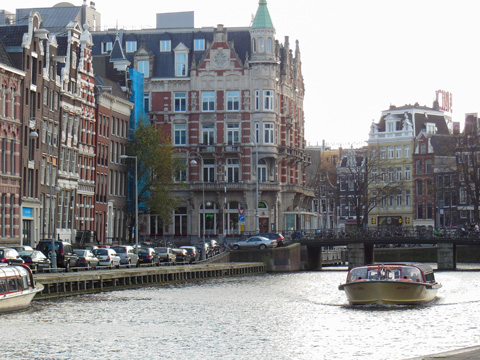2015年1月号 [Vol.25 No.10] 通巻第290号 201501_290003_en
NCGG report
The 7th Non-CO2 greenhouse gas conference (NCGG-7) took place in Amsterdam, capital of Holland, a city of art, canals, and tourists. The meeting keeps following a good tradition of bringing together distant communities ranging from atmospheric science to agriculture and policy making. Plenary sessions attended by all participants provide a platform for learning across the disciplines. It is convenient to be able to hear reports covering whole set of problems related to (for example) emissions of methane and nitrous oxide: regulations of emissions, trends in country level inventory, field observations of agricultural and natural ecosystem fluxes and atmospheric chemistry and transport.
Nitrous oxide emissions by agriculture are strongly linked to the practice of nitrogen fertilizer application. Recent precision agriculture technologies use high spatial resolution harvest record by made by harvester to produce a yield map, which is subsequently used for fertilizer input adjustments. The idea is to compensate for missing yield by adding more nitrogen where yield is lower. In his talk Prof. Rabbinge (Wageningen University) criticized the practice as less efficient compared to opposite technique of adding more fertilizer to more productive plots, which would provide more food with less emissions.
This meeting paid extra attention the black carbon as for its role in the global warming. Studies ranging from Arctic soot to Indonesian fires tell a fresh-faced story of a role played by soot on climate change nowadays. Soot in Arctic has opposite effects on total energy balance, on one hand it can add to sunlight scattering and reflection back to space (cooling effect), on the other hand the soot deposited in the snow reduces reflection of light from the surface in cold season, and helps melting the snow in spring (warming effect).
Interesting talk was delivered by a member of European parliament Bas Eickhout (Green party), who explained the system of European government and environmental law development. He revealed that to understand the system (which few European citizens do) one needs to know duties and powers of the three bodies: European parliament, European commission and Council of Europe.
In our session (Spatial and Interannual variability of the regional CH4 fluxes estimated with GOSAT observations) several remote sensing CH4 concentration products by SCIAMACHY, GOSAT, IASI satellites were used in the estimates of geographical distributions the methane emission and their variations with time. The effort is under way to build more than a decade-long record of CH4 observations from space combining GOSAT and SCIAMACHY data.
Why the meeting always held in Holland?
Why the meeting always held in one country—Holland? Holland is a country known for long tradition in efficient agriculture technologies, and agricultural products: cheese, tulip bulbs, milking cow breeds. There is large volume of research on agricultural methane/nitrous oxide emissions and emissions reduction technologies. The studies of the greenhouse gases and their emissions were inspired by famous scientist of Dutch origin, Nobel Prize winner Paul Crutzen. And Holland always was very nice host for all three meetings I attended.

Boat on canal


